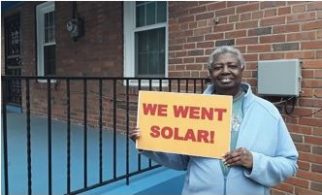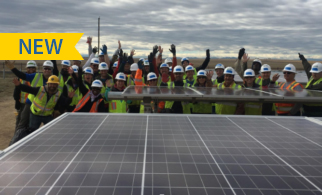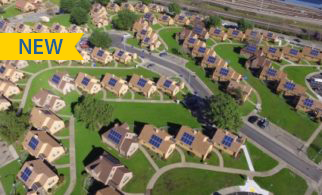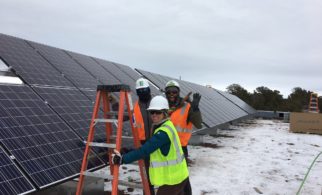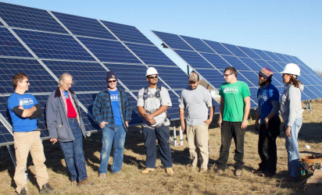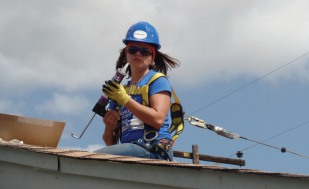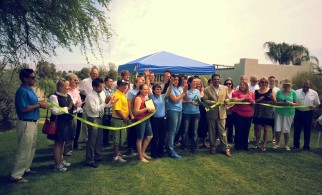Enabling Long-term Funding
Guiding principles: Accessibility and Affordability, Sustainability and Flexibility, Consumer Protection
Barriers addressed: Cost, Market Forces
Low-income access to solar is scalable when long-term funding is allocated through statute and/or regulations, often as part of a broader program, allowing the market to develop sustainably over time. Typically, successful and scalable low-income solar programs are based on an equitable or proportionate access policy: if low‐income customers pay into a pilot or program’s incentive pool as ratepayers or taxpayers, low-income incentives should be created at least in proportion to their contribution to the incentive pool.
Some examples of allocating low-income solar program funding sources in statute and / or regulations and rulemaking are in California, Colorado, District of Columbia, Illinois, and New Hampshire.
California
In 2006, California allocated the California Solar Initiative (CSI) program a 10-year budget of $2.4 billion, collected from electric ratepayers as authorized by SB 1 (Murray, 2006). In 2009, Assembly Bill 2723 required the PUC to ensure that “not less than 10% of the funds for the California Solar Initiative are utilized for the installation of solar energy systems on low-income residential housing.” With this important statute in place creating dedicated long-term funds for low-income solar programs, the California Public Service Commission (CPUC) designed two programs, one for single-family residences (SASH) and one for multifamily residences (MASH). Although the California Solar Initiative was scheduled to sunset in 2016, SASH/MASH were reauthorized by Assembly Bill 217 (Bradford, 2013), with the simple language to “authorize the surcharge collected by the electrical corporations for the California Solar Initiative to continue to provide funding for the administration of the SASH and MASH programs.” Read more about SASH and MASH.
In addition to ratepayer funds, the state allocated California Climate Investments funds (funds generated by its cap-and-trade program) for low-income solar projects through the California Department of Community Services and Development’s Low-Income Weatherization Program (LIWP). SB 535, passed in 2012, required the California Air Resources Board to “allocate a minimum of 25 percent of the available moneys in the fund to projects that provide benefits to [disadvantaged communities]….” Further, the legislation required the Board to “allocate a minimum of 10 percent of the available moneys in the fund to projects located within [disadvantaged communities]….” Disadvantaged communities are defined as the top 25% scoring areas from CalEnviroScreen along with other areas with high amounts of pollution and low populations.
Finally, in 2015, Assembly Bill 693 established a new Multifamily Affordable Housing Solar Roofs Program (MAHSRP) to extend low-income multifamily solar options beyond the existing MASH program. Funding is directed by statute, which “directs the commission to annually authorize the allocation of $100,000,000 or 10% of available funds, whichever is less…from the greenhouse gas allowance revenues received by electrical corporations set aside for clean energy and energy efficiency projects.” In December 2017, the CPUC approved the program under the new name, Solar on Multifamily Affordable Housing (SOMAH). Read more about SOMAH here [link to this page on lowincomesolar.org]
Colorado
The Renewable Energy Standard Adjustment (RESA) is a 2% rider, approved with the Colorado Renewable Energy Standard, to allow utilities to finance the incremental costs of renewable energy. All Investor-Owned Utility ratepayers in Colorado have contributed to the RESA account since 2006, with low-income ratepayers contributing an estimated $71M into the account to date. In the fall of 2016, the Colorado Public Utilities Commission approved a settlement agreement that significantly expands low-income solar programs. Xcel budgeted about $25 million in ratepayer RESA rider funds to support these low-income solar programs for 2017-19.
District of Columbia
The Renewable Portfolio Standard Expansion Amendment Act of 2016 established the District of Columbia’s Solar for All Program (Solar for All) and expanded the use of the Renewable Energy Development Fund (REDF), by stating “From Fiscal Year 2017 through Fiscal Year 2032, the Program shall be funded annually from the Renewable Energy Development Fund established by section 8 of the Renewable Energy Portfolio Standard Act of 2004, effective April 12, 2005 (D.C. Law 15-340; D.C. Official Code§ 34-1436).” Specifically, Section 3(b) of the Act requires the Department of Energy and Environment (the Department or DOEE)-through Solar for All-to “reduce by at least 50% the electric bills of at least 100,000 of the District’s low-income households with high energy burdens by December 31,2032.”
Illinois
In Illinois, the Future Energy Jobs Act directed the money in the ratepayer-funded Renewable Energy Resources Fund to its low-income Solar for All Program using the language “The Illinois Solar for All Program shall include the program offerings…using monies available in the Illinois Power Agency Renewable Energy Resources Fund.” Illinois also directed utility investment toward the Illinois Solar for All Program using the language “The long-term renewable resources procurement plan shall allocate 5% of the funds available under the plan for the applicable delivery year, or $10,000,000 per delivery year, whichever is greater, to fund the programs.” These utility funds for the long-term renewable resources procurement plan will be collected every year (even after the Renewable Energy Resources Fund is spent down), ensuring ongoing funding to support low-income solar programs.
New Hampshire
In 2017, SB 129 mandated that 15 percent of the Alternative Compliance Payment-funded Renewable Energy Fund be dedicated to low-income solar projects, and it increases the portfolio percentage required from solar sources from 0.3 percent to 0.7 percent by 2025. The language was “no less than 15 percent of the funds shall annually benefit low moderate income residential customers, including, but not limited to, the financing or leveraging of financing for low-moderate income community solar projects in manufactured housing communities or in multi-family rental housing.”
